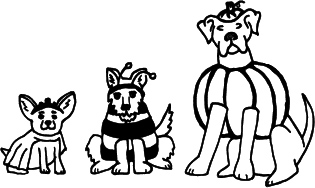Every Halloween, dogs take to the streets in grand fashion: pirate dogs, Superdogs, fairy dogs, bumblebee dogs and pumpkin dogs all trot faithfully beside squealing children and doting parents, tugging at their leashes a little more than usual in hopes of tasty treat. Some dogs weave between the legs of their humans at Halloween parties while others howl in their backyards, overwhelmed at all of the pedestrians in strange clothes. Every Halloween, it’s the same question: what do we do with the dog?
Snickers (affectionately named because of his resemblance to a Snickers candy bar) was adopted by the Holden family in 2011. During Snickers’s puppy years, the answer to the dog-on-Halloween-problem was obvious: quarantine him to his crate. When he grew up a little and learned how to socialize with humans and other dogs appropriately (we’ll call these his teenage years), we had the option to pop him in a hot dog costume and take him out to see the festivities. We had the option, but once we considered Snickers’s spastic and nervous personality, we decided unanimously against it. Even now, as Snickers has moved past what could be called his midlife crisis and has developed a nasty case of arthritis in his back knees, he is far too rowdy for any sort of polyester sweater or elastic headpiece. Knowing perfectly well that costumes are not in my dog’s best interest, I usually don’t get much thought to them—usually.
Many, if not all dogs want to make their owners happy. They stick close to their “packs” and would follow us farther than many of our closest friends. They really like us, which could be part of the reason why lots of dogs have no problem with being dressed up like four-legged American Girl dolls. Most owners figure that if Fido isn’t complaining, then there isn’t anything to be complaining about. That’s where the problem lies.
Snickers has knees that are quite arthritic as well as a weakening lower back. These things are uncommon in a dog his age, so when he first started showing symptoms my family and I didn’t really pay them any mind. It took us far longer than it should have to take him to the vet; we figured if he wasn’t showing us pain, he wasn’t experiencing any. One night, though, I changed my mind. I had been calling Snickers to come inside for a long time and started to pace around the house looking for him. Eventually I found him, curled up in a pile of leaves. He couldn’t get up. I carried him inside, and my mom scheduled a vet appointment for as soon as possible.
The vet, upon prescribing Snickers a little green bottle of pain medication, told my parents that dogs seldom make any obvious sign that they are in pain to their owners. If their knees are giving out from under them or if they’re overheating in a bumblebee costume, it’s the same. Your dog does not have a voice, and you cannot know what he knows. So before you buy that Pikachu costume for $9.99 off Amazon, think about what your pooch might not be telling you.
If you’re set on putting your dog into a costume this Halloween, that’s fine, but there are some guidelines to choosing an outfit that will keep them safe and comfortable:
1. Avoid costumes that get into your dog’s eyes: this can limit vision, and components of the costume can even scratch their eyes.
2. Supervise dressed up dogs, especially puppies. Small costume accessories can be choking hazards.
3. Dress them for the weather. If it’s going to be a warm Halloween, steer away from hot costumes. A costume on top of a fur coat can be too much for some dogs.
4. Make sure your dog can be mobile. Costumes that restrict limb and head movement are uncomfortable, if not dangerous.








